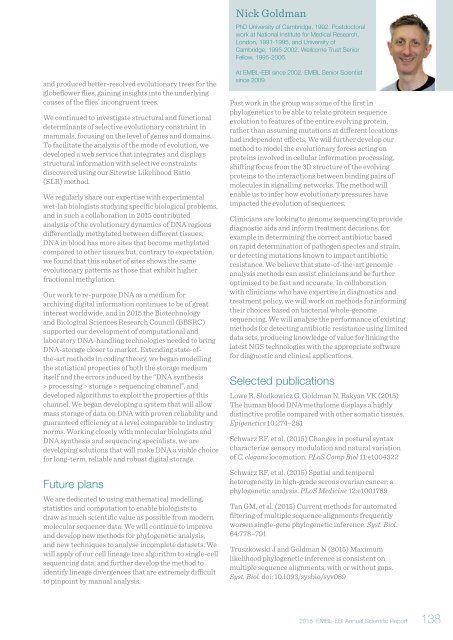Annual Scientific Report 2015
EMBL_EBI_ASR_2015_DigitalEdition
EMBL_EBI_ASR_2015_DigitalEdition
You also want an ePaper? Increase the reach of your titles
YUMPU automatically turns print PDFs into web optimized ePapers that Google loves.
Nick Goldman<br />
PhD University of Cambridge, 1992. Postdoctoral<br />
work at National Institute for Medical Research,<br />
London, 1991-1995, and University of<br />
Cambridge, 1995-2002. Wellcome Trust Senior<br />
Fellow, 1995-2006.<br />
and produced better-resolved evolutionary trees for the<br />
globeflower flies, gaining insights into the underlying<br />
causes of the flies’ incongruent trees.<br />
We continued to investigate structural and functional<br />
determinants of selective evolutionary constraint in<br />
mammals, focusing on the level of genes and domains.<br />
To facilitate the analysis of the mode of evolution, we<br />
developed a web service that integrates and displays<br />
structural information with selective constraints<br />
discovered using our Sitewise Likelihood Ratio<br />
(SLR) method.<br />
We regularly share our expertise with experimental<br />
wet-lab biologists studying specific biological problems,<br />
and in such a collaboration in <strong>2015</strong> contributed<br />
analysis of the evolutionary dynamics of DNA regions<br />
differentially methylated between different tissues.<br />
DNA in blood has more sites that become methylated<br />
compared to other tissues but, contrary to expectation,<br />
we found that this subset of sites shows the same<br />
evolutionary patterns as those that exhibit higher<br />
fractional methylation.<br />
Our work to re-purpose DNA as a medium for<br />
archiving digital information continues to be of great<br />
interest worldwide, and in <strong>2015</strong> the Biotechnology<br />
and Biological Sciences Research Council (BBSRC)<br />
supported our development of computational and<br />
laboratory DNA-handling technologies needed to bring<br />
DNA-storage closer to market. Extending state-ofthe-art<br />
methods in coding theory, we began modelling<br />
the statistical properties of both the storage medium<br />
itself and the errors induced by the “DNA synthesis<br />
> processing > storage > sequencing channel”, and<br />
developed algorithms to exploit the properties of this<br />
channel. We began developing a system that will allow<br />
mass storage of data on DNA with proven reliability and<br />
guaranteed efficiency at a level comparable to industry<br />
norms. Working closely with molecular biologists and<br />
DNA synthesis and sequencing specialists, we are<br />
developing solutions that will make DNA a viable choice<br />
for long-term, reliable and robust digital storage.<br />
Future plans<br />
We are dedicated to using mathematical modelling,<br />
statistics and computation to enable biologists to<br />
draw as much scientific value as possible from modern<br />
molecular sequence data. We will continue to improve<br />
and develop new methods for phylogenetic analysis,<br />
and new techniques to analyse incomplete datasets. We<br />
will apply of our cell lineage tree algorithm to single-cell<br />
sequencing data, and further develop the method to<br />
identify lineage divergences that are extremely difficult<br />
to pinpoint by manual analysis.<br />
At EMBL-EBI since 2002. EMBL Senior Scientist<br />
since 2009.<br />
Past work in the group was some of the first in<br />
phylogenetics to be able to relate protein sequence<br />
evolution to features of the entire evolving protein,<br />
rather than assuming mutations at different locations<br />
had independent effects. We will further develop our<br />
method to model the evolutionary forces acting on<br />
proteins involved in cellular information processing,<br />
shifting focus from the 3D structure of the evolving<br />
proteins to the interactions between binding pairs of<br />
molecules in signalling networks. The method will<br />
enable us to infer how evolutionary pressures have<br />
impacted the evolution of sequences.<br />
Clinicians are looking to genome sequencing to provide<br />
diagnostic aids and inform treatment decisions, for<br />
example in determining the correct antibiotic based<br />
on rapid determination of pathogen species and strain,<br />
or detecting mutations known to impact antibiotic<br />
resistance. We believe that state-of-the-art genomic<br />
analysis methods can assist clinicians and be further<br />
optimised to be fast and accurate. In collaboration<br />
with clinicians who have expertise in diagnostics and<br />
treatment policy, we will work on methods for informing<br />
their choices based on bacterial whole-genome<br />
sequencing. We will analyse the performance of existing<br />
methods for detecting antibiotic resistance using limited<br />
data sets, producing knowledge of value for linking the<br />
latest NGS technologies with the appropriate software<br />
for diagnostic and clinical applications.<br />
Selected publications<br />
Lowe R, Slodkowicz G, Goldman N, Rakyan VK (<strong>2015</strong>)<br />
The human blood DNA methylome displays a highly<br />
distinctive profile compared with other somatic tissues.<br />
Epigenetics 10:274–281<br />
Schwarz RF, et al. (<strong>2015</strong>) Changes in postural syntax<br />
characterize sensory modulation and natural variation<br />
of C. elegans locomotion. PLoS Comp Biol 11:e1004322<br />
Schwarz RF, et al. (<strong>2015</strong>) Spatial and temporal<br />
heterogeneity in high-grade serous ovarian cancer: a<br />
phylogenetic analysis. PLoS Medicine 12:e1001789<br />
Tan GM, et al. (<strong>2015</strong>) Current methods for automated<br />
filtering of multiple sequence alignments frequently<br />
worsen single-gene phylogenetic inference. Syst. Biol.<br />
64:778–791<br />
Truszkowski J and Goldman N (<strong>2015</strong>) Maximum<br />
likelihood phylogenetic inference is consistent on<br />
multiple sequence alignments, with or without gaps.<br />
Syst. Biol. doi: 10.1093/sysbio/syv089<br />
<strong>2015</strong> EMBL-EBI <strong>Annual</strong> <strong>Scientific</strong> <strong>Report</strong> 138


